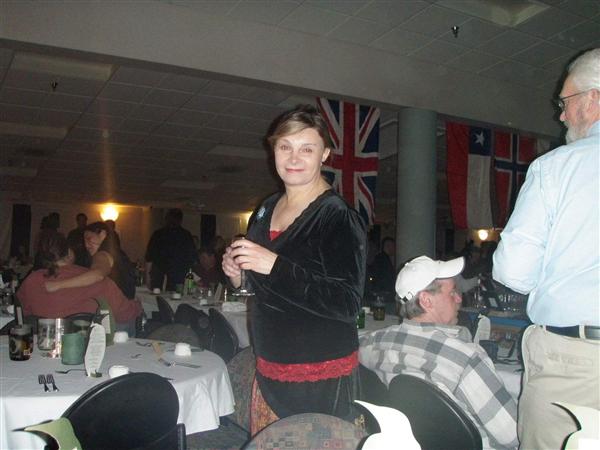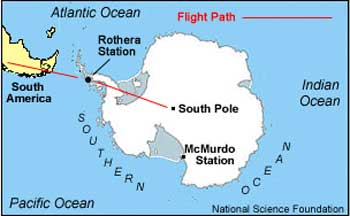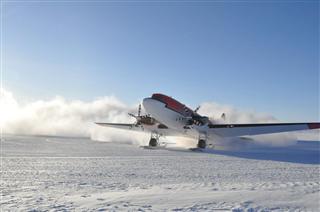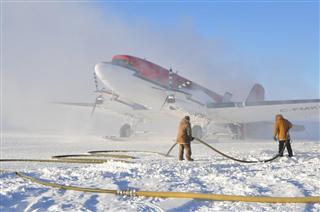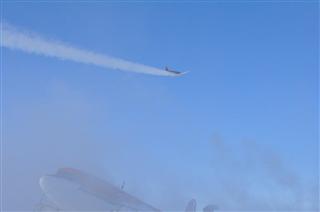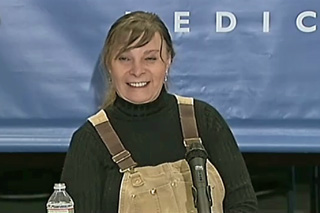Renée Nicole Douceur
|
On 27 August 2011, the winter site manager, Renée-Nicole Douceur (above) suffered an apparent stroke. The 58-year-old engineer from New Hampshire was sitting at her desk, when suddenly half of her computer screen disappeared. She immediately sought help from the two physicians on station; the clinic is well stocked but does not offer CT/MRI equipment. A medevac was considered but not implemented, as her condition seemed stable. A month later, her niece decided to raise the issue to the world media. She requested assistance from New Hampshire Senator Geanne Shaheen, created the saverenee.org web site and a Facebook page (now both gone), and started a White House petition to stir up interest in Renée's plight. During the first week of October she was interviewed by the media, including Christchurch Press, the New York Times, and Discovery News...and all 3 stories garnered many comments. She continued to suffer from blurry vision and difficulty concentrating. Renée first went to the ice in 2008-09, wintering at McM in 2009 as the facilities engineer (the photo above is from that midwinter dinner).
| ||
|
Renée Nicole Douceur's flight from Pole arrived in McMurdo early Monday afternoon 17 October SP time...she boarded the regularly scheduled C-17 at 1620...and the flight to Christchurch arrived in Christchurch at 2155 TVNZ news item from the Tuesday Breakfast news with link to video of the C-17 landing and an interview inside the airport, a Christchurch Press article, and an Associated Press report. She was offered a bed and a sedative on the flight to ChCh, and she basically slept all the way. Renée had an MRI and other medical tests on Tuesday 18 October (saverenee.org report), and received the results the next day. According to her, "Preliminary finding is a lacunar stroke (subcortical) left side of brain in a small (micro) blood vessel that actually could not be imaged by the MRI. The neurologist said with proper treatment / rehabilitation he expected a very good recovery though not 100%." There was dead brain tissue evident...a sign of a clot, but no sign of a tumor. The medical details were sent to the University of Texas Medical Branch (UTMB) in Galveston (the USAP-subcontracted medical support team) as well as Johns Hopkins in Baltimore. Other news...a Wednesday (US time) seacoastonline (New Hampshire) report and a Thursday morning Christchurch Press article. Renée left NZ the following Monday morning, and arrived in Baltimore on Monday evening 24 October US time. She then checked into the hospital at Johns Hopkins. On Tuesday 25 October she was undergoing tests...another MRI, other neurology tests, and an eye exam. Doctors told her she would come close to full recovery...and she was to undergo rehab therapy in Vermont. Then she hoped to head west to recover her Jeep in Denver and her custom motor coach (Gypsy Queen) in which she's lived and explored the country for the past few years. She also hoped to be able to PQ for another ice job (25 October Boston Globe article).
Renée was cleared to leave the Johns Hopkins hospital on Wednesday 2 November; she planned to head to Vermont to stay with friends. For reference, if you are curious about how medevac flights work, here is my coverage of the April 2001 medevac of Dr. Ron Shemenski...and the September 2003 medevac of Barry McCue, with detailed timelines of how things went (note that these medevacs used slower Twin Otter aircraft rather than Baslers). | ||
